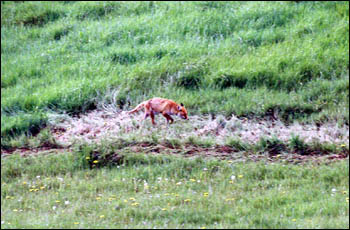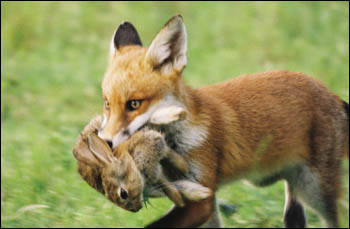
![]()
![]()

![]()
![]()
Watching foxes
Watching foxes can be extremely enjoyable and reveals many truths about the animal. In rural areas daytime observation is possible while in urban areas it is best to leave it until night-time. The most productive place will be at the breeding earth, otherwise it is often a hit and miss affair, but if roughly the time and place are known, it saves a lot of waiting around and cuts down on unproductive watches. In areas of low persecution and high fox population, observation should be easier.
The size of the territory makes a lot of difference in whether you see your foxes regularly or seldom. Both depend on the availability of food. If food is scarce the foxes have to travel further afield to find it and therefore have vast territories. If, on the other hand, food is plentiful, the territory will hold a larger fox population and be smaller, since it won't be necessary for the foxes to travel so far.
Daytime watching: This is most productive during Spring and Summer. The most rewarding places to watch are:

Daytime fox in the West of Ireland following a farm tractor trail.
When watching at breeding earths spend as much time as possible there, always keeping downwind and not too close. The cubs may be moved by the vixen if she knows a human being is around, though some will tolerate a minimum amount of disturbance. The cubs are quite often moved anyway, to be introduced to other earths and perhaps different parts of the territory, although they are usually brought back to the original earth. Some times the litter is split up, with only half the cubs being taken to another earth - it is not known why the parents do this. Cubs first start appearing out of the earths during April and sometimes May.
If possible, position yourself at an earth before dawn and stay all day until nightfall. Activity should be constant throughout the day, but sometimes cubs will go to ground to rest. The parents often leave the cubs alone for hours and they remain quite active and start to explore during daylight. This is the ideal occasion to quietly take photographs. The parents bring food to the cubs during the day at this time of year and you will gradually get to know their approach routes. The vixen will suckle the cubs above ground now also. At some earths there will almost always be an adult around. This is common in urban foxes, when there will be a babysitter or helper.
Cubs usually show little fear of man when first exploring around the earth and can be approached closely at this stage of playing and learning to catch beetles.
Late April/early May is a good time to sit near a rabbit warren at dawn or early evening to watch for an adult hunting. The parents are under more pressure to hunt by day now as the cubs are hungry and growing fast. It's best to be patient and wait well into the morning or well before dusk, keeping well concealed and downwind. When hunting for mice, foxes can be seen at almost any time of the day in cub season or can be seen pouncing for them in thick snow during the deep of winter. In February also they are very active and can be seen hunting during the day.

Young foxes are already skilled hunters by mid-Summer.
This one has caught and killed its own rabbit.
Night-time Watching: This will be easier in urban areas where there are street lamps. Activity starts later at night than in the country. Urban foxes are ideal to lay down food for to observe their social behaviour. They are normally easier to get close to than rural foxes, since they suffer less persecution and tend to live in bigger social groups. Foxes can be watched in the countryside too at night, but image intensifiers are required or a more affordable high powered lamp can be used. Foxes will often ignore a beam of light but because high powered lamps are often used when shooting foxes, many have become shy of lights. The white torch light will usually be ignored as they emerge from their earths, providing you are downwind and extremely quiet.
![]()
![]()